wheel PEUGEOT 108 2015 Owners Manual
[x] Cancel search | Manufacturer: PEUGEOT, Model Year: 2015, Model line: 108, Model: PEUGEOT 108 2015Pages: 271, PDF Size: 7.42 MB
Page 4 of 271
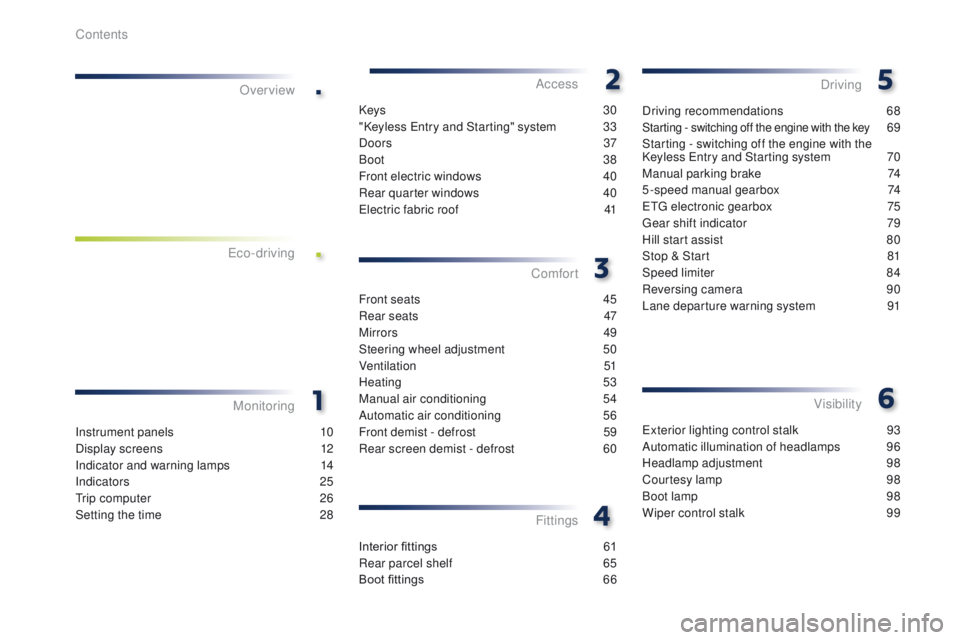
.
.
108_en_Chap00a_sommaire_ed01-2015
exterior lighting control stalk 93
A utomatic illumination of headlamps
9
6
Headlamp adjustment
9
8
Courtesy lamp
9
8
Boot lamp
9
8
Wiper control stalk
9
9
Visibility
Instrument panels 1 0
Display screens
1
2
Indicator and warning lamps
1
4
Indicators
25
tr
ip computer
2
6
Setting the time
2
8
MonitoringOver view
Keys
30
"Keyless e
n
try and Starting" system
3
3
Doors
37
Boo
t
38
Front electric windows
4
0
Rear quarter windows
4
0
ele
ctric fabric roof
4
1
Access
Front seats 4 5
Rear seats
4
7
Mirrors
4
9
Steering wheel adjustment
5
0
Ventilation
5
1
Heating
53
Manual air conditioning
5
4
Automatic air conditioning
5
6
Front demist - defrost
5
9
Rear screen demist - defrost
6
0
Comfort
Interior fittings 61
Rear parcel shelf
6
5
Boot fittings
6
6
Fittings
Driving recommendations 68
Starting - switching off the engine with the key 69
Starting - switching off the engine with the
Keyless
e
n
try and Starting system
7
0
Manual parking brake
7
4
5-speed manual gearbox
7
4
e
tg
el
ectronic gearbox
7
5
ge
ar shift indicator
7
9
Hill start assist
8
0
Stop & Start
8
1
Speed limiter
8
4
Reversing camera
9
0
Lane departure warning system
9
1
Driving
e
co-driving
Contents
Page 5 of 271
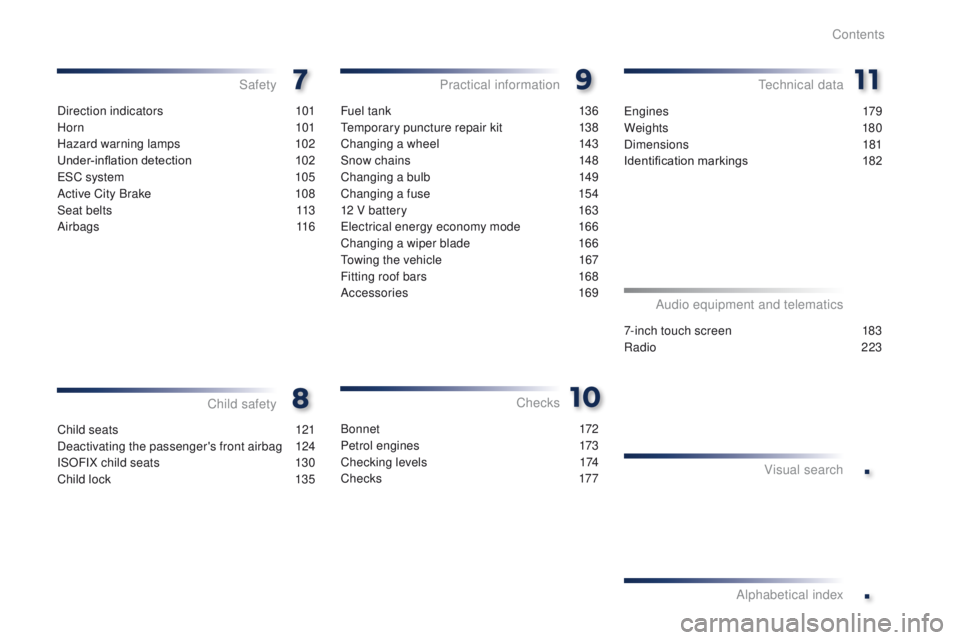
.
.
108_en_Chap00a_sommaire_ed01-2015
Direction indicators 101
Horn
10
1
Hazard warning lamps
1
02
Under-inflation detection
1
02
e
SC system
1
05
Active City Brake
1
08
Seat belts
1
13
Airbags
116
Safety
Child seats 1 21
Deactivating the passenger's front airbag
1
24
ISOFIX child seats
1
30
Child lock
1
35
Child safety Checks
Fuel tank 1
36
te
mporary puncture repair kit
1
38
Changing a wheel
1
43
Snow chains
1
48
Changing a bulb
1
49
Changing a fuse
1
54
12 V battery
1
63
el
ectrical energy economy mode
1
66
Changing a wiper blade
1
66
to
wing the vehicle
1
67
Fitting roof bars
1
68
Accessories
169
Practical informationte chnical data
7-inch touch screen 183
Radio 223
Audio equipment and telematics
Visual search
Alphabetical index
B o n n et 17 2
Petrol engines
1
73
Checking levels
1
74
C h e c ks
17 7
en
gines
1
79
Weights
180
Dimensions
1
81
Identification markings
1
82
Contents
Page 9 of 271
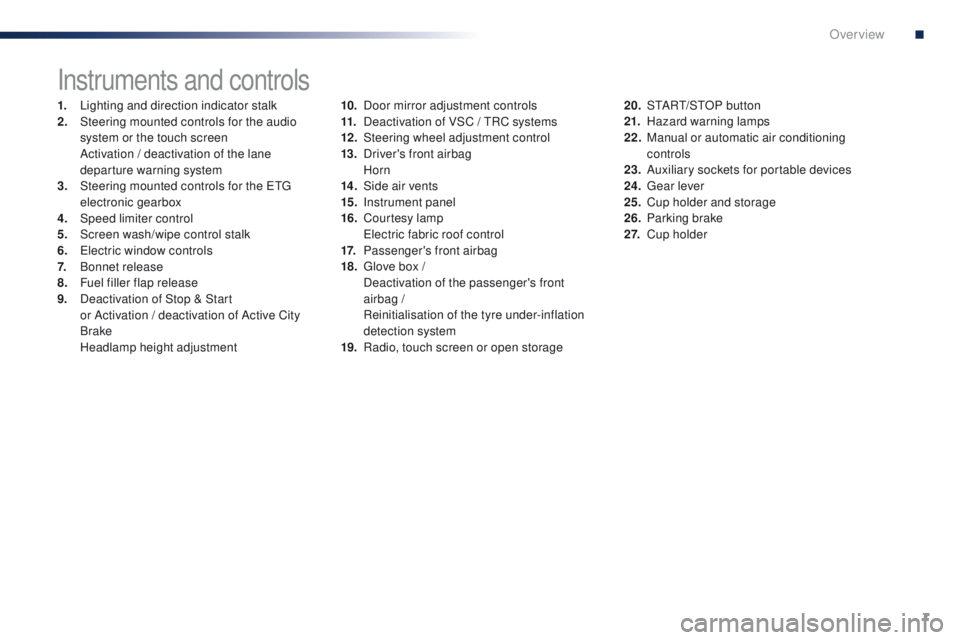
7
108_en_Chap00b_vue-ensemble_ed01-2015
Instruments and controls
1. Lighting and direction indicator stalk
2. Steering mounted controls for the audio
system or the touch screen
A
ctivation / deactivation of the lane
departure warning system
3.
S
teering mounted controls for the etg
electronic gearbox
4.
Spe
ed limiter control
5.
S
creen wash/wipe control stalk
6.
e
le
ctric window controls
7.
B
onnet release
8.
F
uel filler flap release
9.
D
eactivation of Stop & Start
or
Activation / deactivation of Active City
Brake
H
eadlamp height adjustment 10. D
oor mirror adjustment controls
11. D eactivation of VSC / tR C systems
12 .
S
teering wheel adjustment control
13.
D
river's front airbag
Horn
14 .
S
ide air vents
15.
I
nstrument panel
16.
C
ourtesy lamp
e
le
ctric fabric roof control
17.
P
assenger's front airbag
18.
g
l
ove box /
D
eactivation of the passenger's front
airbag /
R
einitialisation of the tyre under-inflation
detection system
19.
R
adio, touch screen or open storage20. S
tA Rt/ S tO P button
21. H azard warning lamps
22.
M
anual or automatic air conditioning
controls
23.
A
uxiliary sockets for portable devices
24.
g
ea
r lever
25.
C
up holder and storage
26.
P
arking brake
2 7.
C
up holder
.
Over view
Page 11 of 271
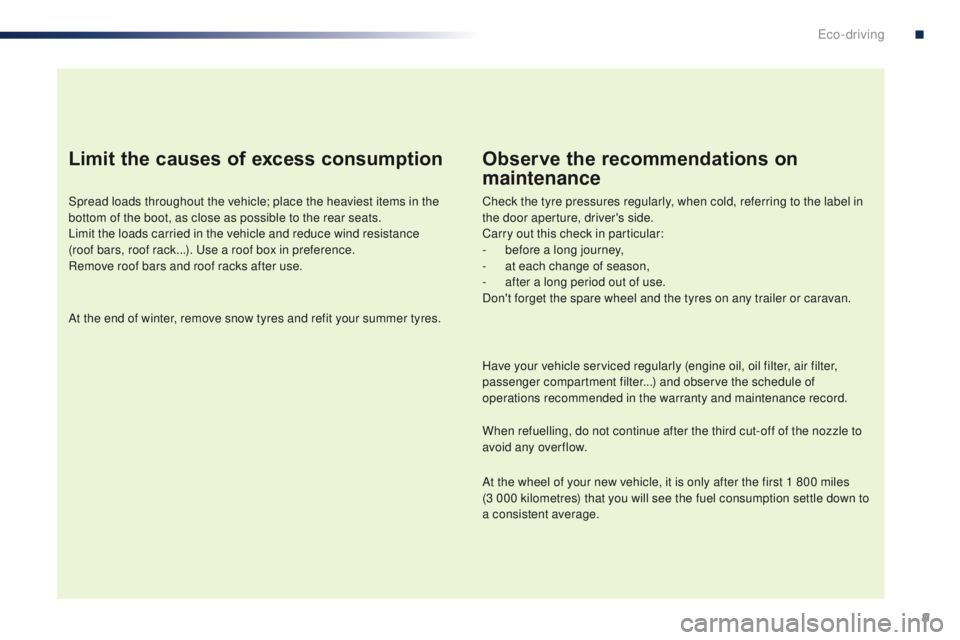
9
108_en_Chap00c_eco-conduite_ed01-2015
Limit the causes of excess consumption
Spread loads throughout the vehicle; place the heaviest items in the
bottom of the boot, as close as possible to the rear seats.
Limit the loads carried in the vehicle and reduce wind resistance
(roof bars, roof rack...). u
s
e a roof box in preference.
Remove roof bars and roof racks after use.
At the end of winter, remove snow tyres and refit your summer tyres.
Observe the recommendations on
maintenance
Check the tyre pressures regularly, when cold, referring to the label in
the door aperture, driver's side.
Carry out this check in particular:
-
b
efore a long journey,
-
a
t each change of season,
-
a
fter a long period out of use.
Don't forget the spare wheel and the tyres on any trailer or caravan.
Have your vehicle serviced regularly (engine oil, oil filter, air filter,
passenger compartment filter...) and observe the schedule of
operations recommended in the warranty and maintenance record.
When refuelling, do not continue after the third cut-off of the nozzle to
avoid any over flow.
At the wheel of your new vehicle, it is only after the first 1 800 miles
(3
000 kilometres) that you will see the fuel consumption settle down to
a consistent average.
.
eco-driving
Page 20 of 271
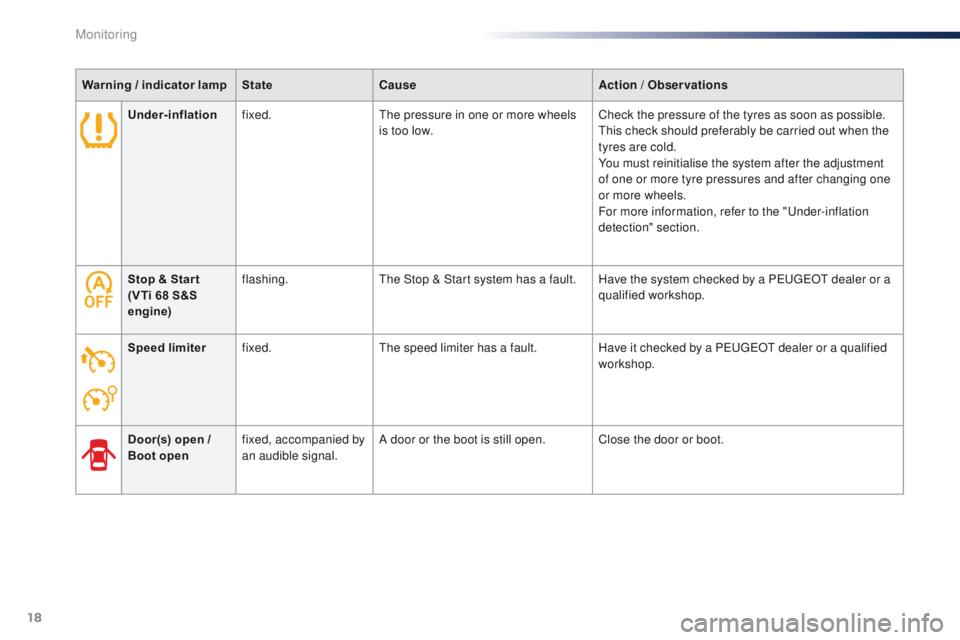
18
Stop & Star t
(VTi 68 S&S
engine)flashing.th
e Stop & Start system has a fault. Have the system checked by a Pe ugeOt dealer or a
qualified workshop.
Speed limiter fixed.
th
e speed limiter has a fault.Have it checked by a P
e
uge
Ot
dealer or a qualified
workshop.
Door(s) open /
Boot open fixed, accompanied by
an audible signal. A door or the boot is still open. Close the door or boot.
Warning / indicator lamp
StateCause Action / Observations
Under-inflation fixed.
th
e pressure in one or more wheels
is too low. Check the pressure of the tyres as soon as possible.
th
is check should preferably be carried out when the
tyres are cold.
You must reinitialise the system after the adjustment
of one or more tyre pressures and after changing one
or more wheels.
For more information, refer to the "
un
der-inflation
detection" section.
Monitoring
Page 21 of 271
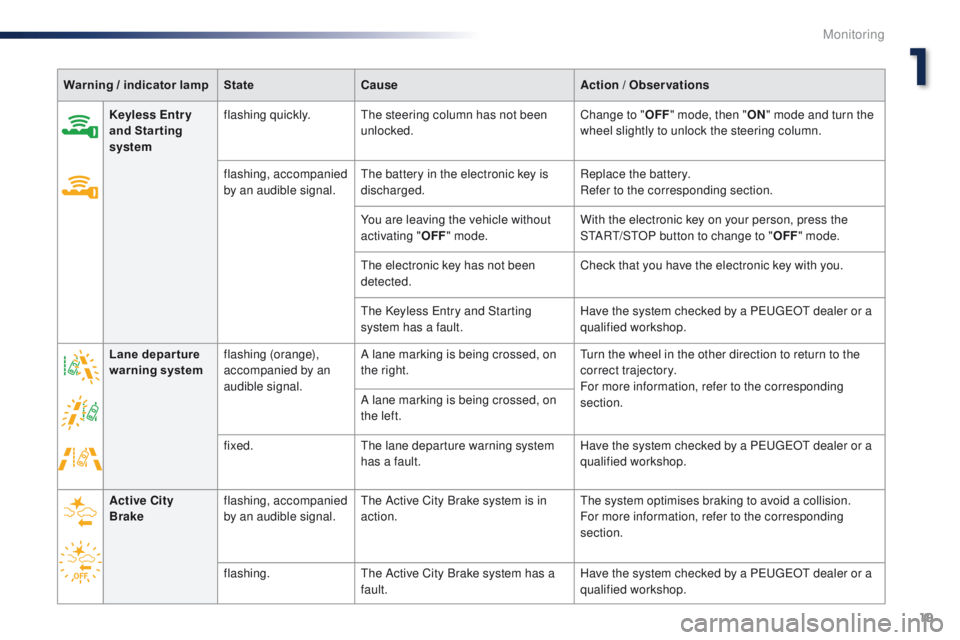
19
108_en_Chap01_controle-de-marche_ed01-2015
Warning / indicator lampStateCause Action / Observations
Keyless Entr y
and Starting
system flashing quickly.
th
e steering column has not been
unlocked. Change to "
OFF" mode, then " ON" mode and turn the
wheel slightly to unlock the steering column.
flashing, accompanied
by an audible signal.
th
e battery in the electronic key is
discharged. Replace the battery.
Refer to the corresponding section.
You are leaving the vehicle without
activating " OFF" mode. With the electronic key on your person, press the
S
tA
R
t/
S
tO
P button to change to "OFF" mode.
th
e electronic key has not been
detected. Check that you have the electronic key with you.
th
e Keyless e
n
try and Starting
system has a fault. Have the system checked by a P
e
uge
Ot
dealer or a
qualified workshop.
Lane depar ture
warning system flashing (orange),
accompanied by an
audible signal. A lane marking is being crossed, on
the right.
tu
rn the wheel in the other direction to return to the
correct trajectory.
For more information, refer to the corresponding
section.
A lane marking is being crossed, on
the left.
fixed.
th
e lane departure warning system
has a fault. Have the system checked by a P
e
uge
Ot
dealer or a
qualified workshop.
Active City
Brake flashing, accompanied
by an audible signal.
th
e Active City Brake system is in
action.
th
e system optimises braking to avoid a collision.
For more information, refer to the corresponding
section.
flashing.
th
e Active City Brake system has a
fault. Have the system checked by a P
e
uge
Ot
dealer or a
qualified workshop.
1
Monitoring
Page 52 of 271
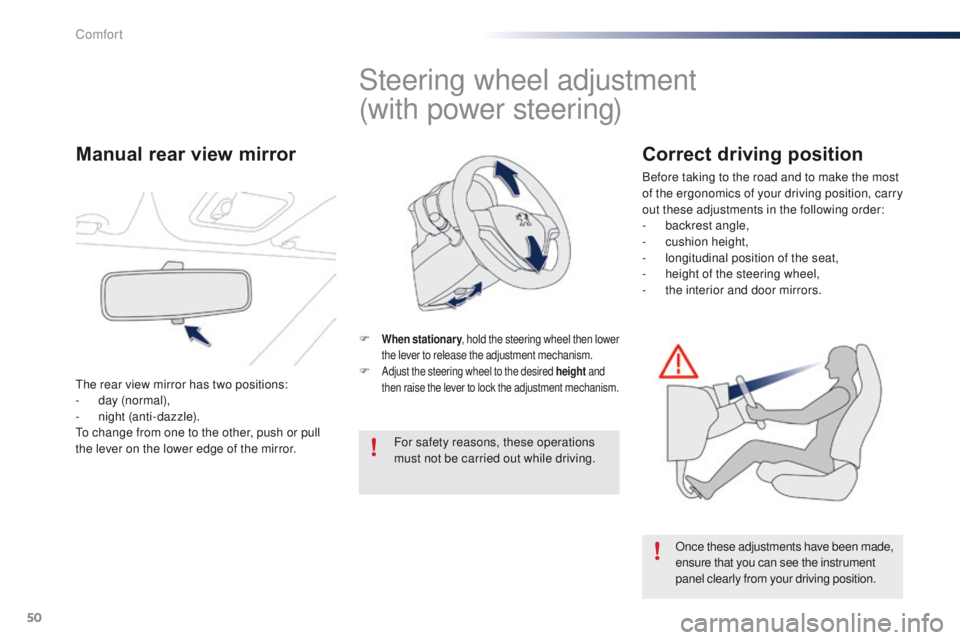
50
108_en_Chap03_confort_ed01-2015
Steering wheel adjustment
(with power steering)
F When stationary, hold the steering wheel then lower
the lever to release the adjustment mechanism.
F Adjust the steering wheel to the desired height and
then raise the lever to lock the adjustment mechanism.
For safety reasons, these operations
must not be carried out while driving.
Once these adjustments have been made,
ensure that you can see the instrument
panel clearly from your driving position.
Manual rear view mirror
the rear view mirror has two positions:
- d ay (normal),
-
n
ight (anti-dazzle).
to c
hange from one to the other, push or pull
the lever on the lower edge of the mirror.
Correct driving position
Before taking to the road and to make the most
of the ergonomics of your driving position, carry
out these adjustments in the following order:
-
b
ackrest angle,
-
c
ushion height,
-
l
ongitudinal position of the seat,
-
hei
ght of the steering wheel,
-
t
he interior and door mirrors.
Comfort
Page 68 of 271
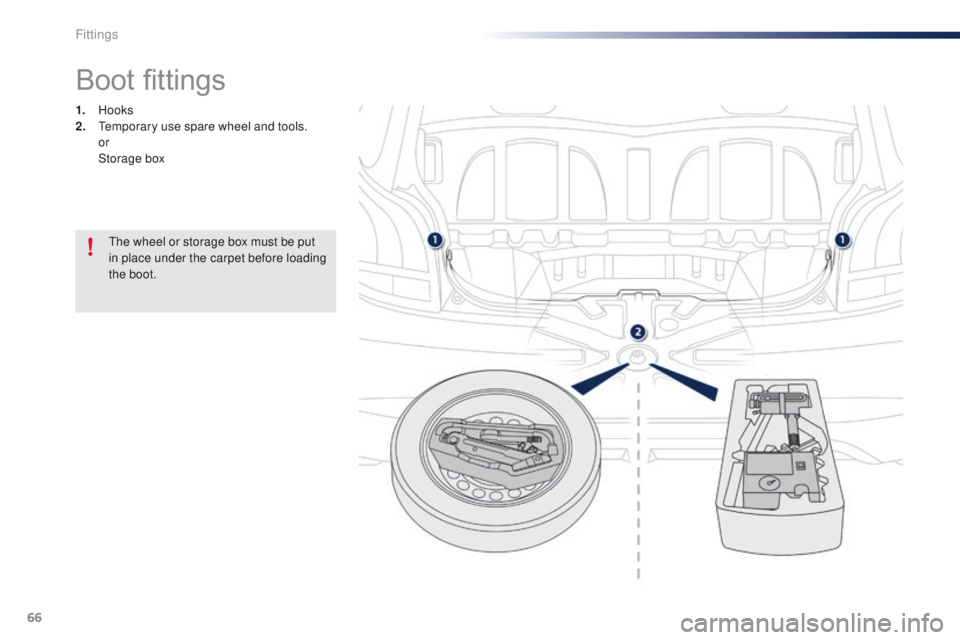
66
108_en_Chap04_amenagements_ed01-2015
Boot fittings
1. Hooks
2. te mporary use spare wheel and tools.
or
St
orage box
th
e wheel or storage box must be put
in place under the carpet before loading
the boot.
Fittings
Page 70 of 271
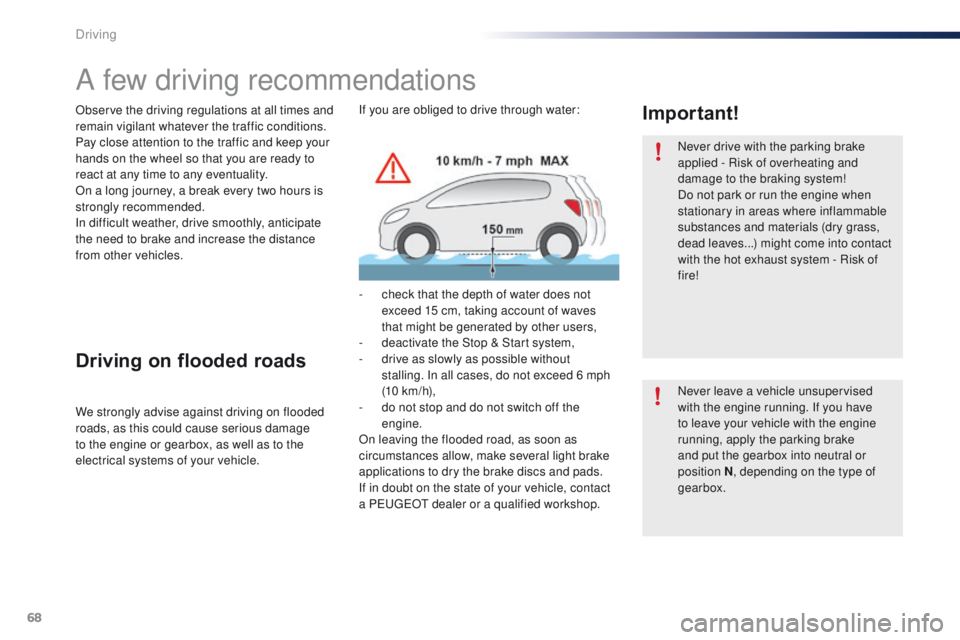
68
108_en_Chap05_conduite_ed01-2015
A few driving recommendations
Observe the driving regulations at all times and
remain vigilant whatever the traffic conditions.
Pay close attention to the traffic and keep your
hands on the wheel so that you are ready to
react at any time to any eventuality.
On a long journey, a break every two hours is
strongly recommended.
In difficult weather, drive smoothly, anticipate
the need to brake and increase the distance
from other vehicles.Never drive with the parking brake
applied - Risk of overheating and
damage to the braking system!
Do not park or run the engine when
stationary in areas where inflammable
substances and materials (dry grass,
dead leaves...) might come into contact
with the hot exhaust system - Risk of
fire!
Never leave a vehicle unsupervised
with the engine running. If you have
to leave your vehicle with the engine
running, apply the parking brake
and put the gearbox into neutral or
position
N, depending on the type of
gearbox.
Driving on flooded roads
We strongly advise against driving on flooded
roads, as this could cause serious damage
to the engine or gearbox, as well as to the
electrical systems of your vehicle.
Important!If you are obliged to drive through water:
-
c
heck that the depth of water does not
exceed 15 cm, taking account of waves
that might be generated by other users,
-
d
eactivate the Stop & Start system,
-
d
rive as slowly as possible without
stalling. In all cases, do not exceed 6 mph
(10
km/h),
-
d
o not stop and do not switch off the
engine.
On leaving the flooded road, as soon as
circumstances allow, make several light brake
applications to dry the brake discs and pads.
If in doubt on the state of your vehicle, contact
a P
e
uge
Ot
dealer or a qualified workshop.
Driving
Page 71 of 271
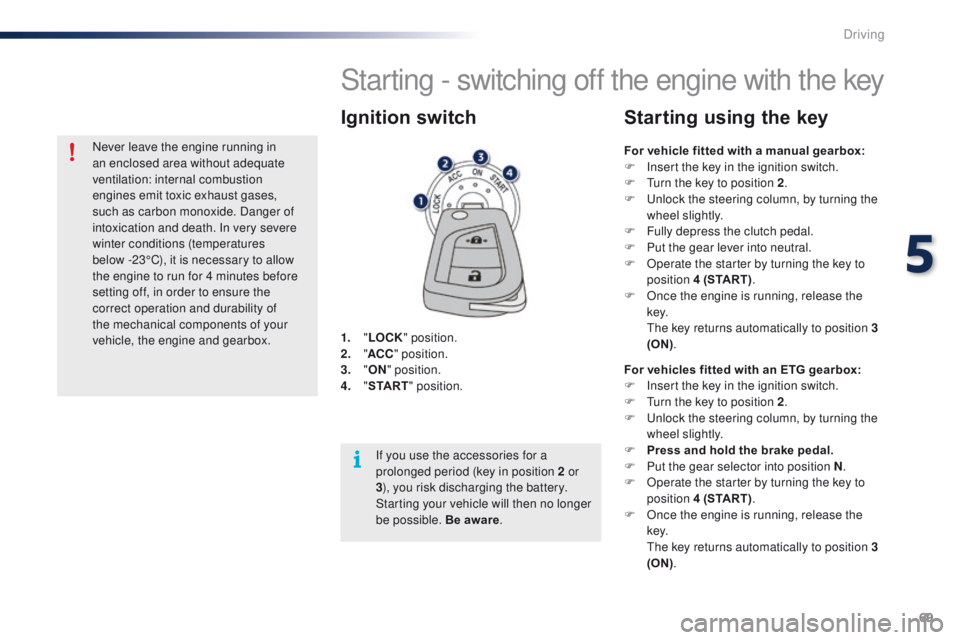
69
108_en_Chap05_conduite_ed01-2015
Starting - switching off the engine with the key
1. "LOCK " position.
2. " AC
C" position.
3.
"ON " position.
4.
" S
TA R T" position.
Ignition switch
For vehicle fitted with a manual gearbox:
F
I nsert the key in the ignition switch.
F
t
u
rn the key to position 2 .
F
u
n
lock the steering column, by turning the
wheel slightly.
F
F
ully depress the clutch pedal.
F
P
ut the gear lever into neutral.
F
O
perate the starter by turning the key to
position 4 (START) .
F
O
nce the engine is running, release the
key.
t
h
e key returns automatically to position 3
(ON) .
Starting using the key
For vehicles fitted with an ETG gearbox:
F
I nsert the key in the ignition switch.
F
t
u
rn the key to position 2 .
F
u
n
lock the steering column, by turning the
wheel slightly.
F
P
ress and hold the brake pedal.
F
P
ut the gear selector into position N .
F
O
perate the starter by turning the key to
position 4 (START) .
F
O
nce the engine is running, release the
key.
t
h
e key returns automatically to position 3
(ON) .
If you use the accessories for a
prolonged period (key in position 2 or
3
), you risk discharging the battery.
Starting your vehicle will then no longer
be possible. Be aware .
Never leave the engine running in
an enclosed area without adequate
ventilation: internal combustion
engines emit toxic exhaust gases,
such as carbon monoxide. Danger of
intoxication and death. In very severe
winter conditions (temperatures
below
-23°C), it is necessary to allow
the engine to run for 4 minutes before
setting off, in order to ensure the
correct operation and durability of
the mechanical components of your
vehicle, the engine and gearbox.
5
Driving